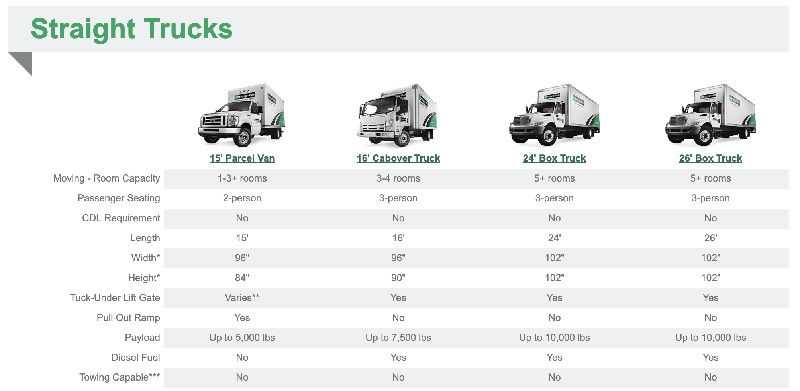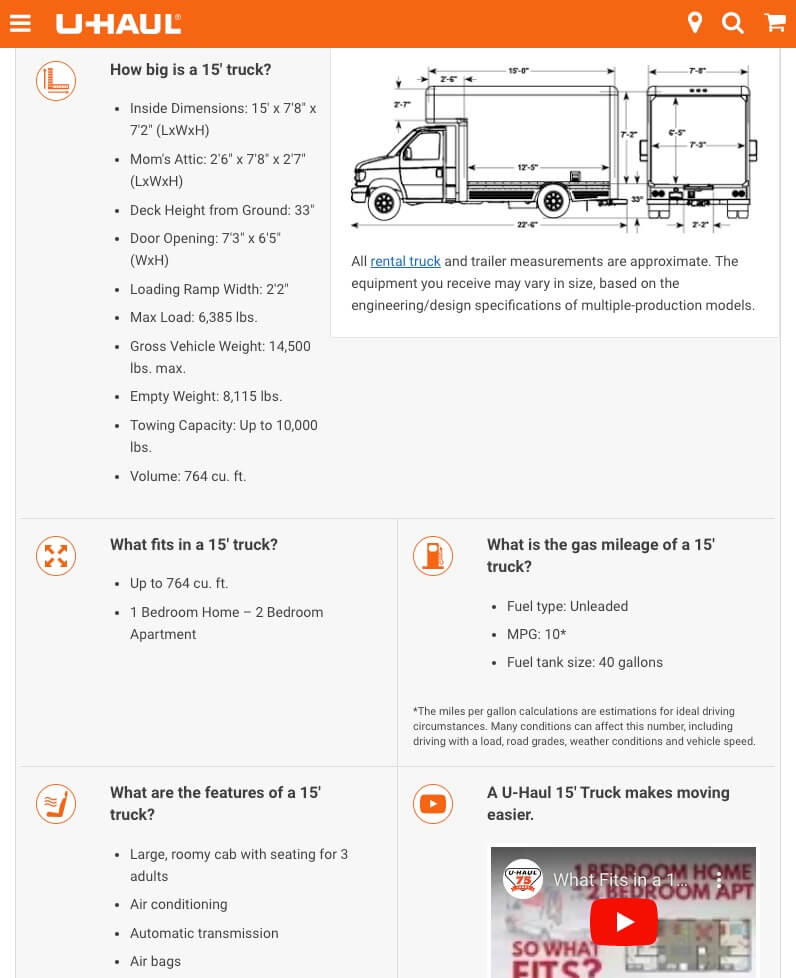U-Haul Truck One Way: Your Comprehensive Guide to Long-Distance Moving sale.truckstrend.com
Moving across state lines or even just across a vast metropolitan area can be a daunting task. The logistics of transporting your entire life from one point to another require careful planning, reliable equipment, and often, a service designed specifically for such journeys. This is where the U-Haul Truck One Way service shines, offering a flexible and convenient solution for individuals and families embarking on long-distance relocations.
U-Haul’s one-way rental service is fundamentally different from a local rental. Instead of returning the truck to the same location where you picked it up, you pick up the moving truck at a U-Haul center near your origin and drop it off at a different U-Haul location near your destination. This unique capability eliminates the need for a round trip, saving movers significant time, mileage, and effort. It’s an indispensable service for college students moving to a new campus, military personnel relocating to a new base, families settling into a new home, or individuals pursuing new job opportunities in distant cities. Understanding the intricacies of this service is key to a smooth and stress-free move. This comprehensive guide will delve into every aspect of U-Haul Truck One Way, from understanding the fleet to navigating the rental process, and offering practical advice for your long-distance journey.
U-Haul Truck One Way: Your Comprehensive Guide to Long-Distance Moving
Understanding U-Haul One-Way Moves
At its core, a U-Haul one-way move is about ultimate convenience for long-haul transportation. Unlike a local rental where you might use a truck for a few hours to move furniture across town and return it to the same lot, a one-way rental allows you to pick up a truck in one city and drop it off in an entirely different city, often hundreds or thousands of miles away. This design caters specifically to the unique demands of interstate or long-distance intrastate moves.
The "one-way" designation means the rental rate is structured to account for the single journey, often including a set number of miles and a specific number of rental days. This model removes the burden of driving an empty truck back to the original pick-up point, saving movers valuable time, fuel, and the logistical nightmare of a pointless return trip. This service is ideal for anyone whose destination is too far to reasonably return the truck, making it a cornerstone of self-service long-distance moving.
The Fleet: U-Haul Truck Sizes for One-Way Moves
U-Haul offers a diverse fleet of moving trucks, each designed to accommodate different moving needs, from a small studio apartment to a large family home. Choosing the right size is crucial to ensure you have enough space without paying for unnecessary capacity. All U-Haul trucks are built for moving and come with features like low decks and wide loading ramps for easier loading, as well as gentle ride suspensions for protecting your belongings.
Here’s a breakdown of the common truck sizes available for one-way rentals:

- 10′ Truck: The smallest box truck, ideal for studio or 1-bedroom apartments. It’s easy to drive and park, making it a popular choice for smaller moves.
- 15′ Truck: Suitable for 1-2 bedroom homes or larger apartments. It offers significantly more space than the 10′ truck and is a common choice for those upgrading from apartment living.
- 17′ Truck: A slightly larger option than the 15′ truck, often recommended for 2-3 bedroom homes. It provides that extra bit of space for bulkier items or a slightly larger volume of belongings.
- 20′ Truck: Designed for 2-3 bedroom homes or larger apartments with more furniture. This size offers ample space for most average family moves.
- 26′ Truck: The largest truck in the U-Haul fleet, perfect for 3-4+ bedroom homes. If you have a large household or numerous bulky items, this truck is likely your best bet.

Choosing the Right Size: U-Haul provides online tools and estimators to help you determine the best truck size based on the number of rooms you’re moving. It’s often advisable to err on the side of a slightly larger truck if you’re unsure, as an overloaded truck can lead to multiple trips, wasted time, and potential safety hazards.
The U-Haul One-Way Rental Process: A Step-by-Step Guide

Renting a U-Haul truck for a one-way move is a straightforward process, but understanding each step can ensure a smooth experience.
Step 1: Making Your Reservation
- Online: The most popular method. Visit U-Haul’s website, enter your desired pick-up and drop-off locations, dates, and select the truck size. You can also add moving supplies, towing equipment, and insurance during this step.
- Phone: Call U-Haul’s reservation line. A representative can guide you through the options.
- In-Person: Visit a local U-Haul center. This can be helpful if you want to see the trucks or discuss your needs with staff directly.
Key Information Needed: Be prepared to provide your pick-up and drop-off locations, desired dates, estimated truck size, and personal information (name, contact, driver’s license details).
Step 2: Confirmation & Preparation
Once reserved, you’ll receive a confirmation email detailing your reservation. Read it carefully, paying attention to pick-up times, location, and any additional items. Ensure you have a valid driver’s license (must be 18+ to rent a truck, 16+ for trailers) and a valid credit card for payment and security deposit (if applicable).
Step 3: Truck Pick-up
- Location: Arrive at your designated U-Haul pick-up location at the scheduled time. It could be a U-Haul owned and operated center or an independent dealer.
- Inspection: Before driving off, thoroughly inspect the truck for any existing damage. Note it on the rental agreement or take photos/videos. Check the fuel level and mileage.
- Documentation: Review and sign the rental agreement. Understand the mileage allowance, rental duration, and any additional charges.
Step 4: The Drive
- Driving Dynamics: Remember you’re driving a larger, heavier vehicle. Allow for extra braking distance, wider turns, and be mindful of overhead clearances. U-Haul trucks are designed to be relatively easy to drive, but they are not cars.
- Fuel Management: U-Haul trucks typically run on unleaded gasoline. Plan your fuel stops, especially on long journeys, and consider fuel economy differences between truck sizes.
- Route Planning: Use GPS, but be aware of routes that may restrict commercial vehicles or have low bridges.
Step 5: Truck Drop-off
- Designated Location: Return the truck to the specified U-Haul drop-off location.
- Fuel & Cleanliness: Return the truck with the same amount of fuel as when you picked it up (usually "¼ tank or more"). Clean out any trash or debris. Failure to do so can result in additional charges.
- Final Inspection: The U-Haul representative will inspect the truck for new damage and confirm mileage and fuel level.
- Key Return: Follow the location’s instructions for key return, which may include an after-hours drop box.
Key Considerations for Your U-Haul One-Way Move
Several factors influence the cost and experience of your U-Haul one-way rental. Being aware of these can help you plan better and avoid surprises.
- Pricing Structure: One-way pricing is dynamic. It’s a flat rate for the duration and distance of your specific trip, rather than a daily rate plus mileage. This rate is influenced by truck size, distance, demand for trucks at your origin/destination, and time of year. The quoted price includes a set number of miles and days. Exceeding these incurs additional charges.
- Availability: Demand for one-way trucks can fluctuate significantly. Peak moving seasons (summer, end-of-month, holidays) often see limited availability and higher prices. Booking well in advance (4-6 weeks, or even more for summer moves) is highly recommended. Being flexible with your pick-up or drop-off dates/locations can also increase availability and potentially lower costs.
- Fuel Efficiency: Larger trucks naturally consume more fuel. While U-Haul trucks are designed for efficiency, expect lower MPG than your personal vehicle. Factor fuel costs into your overall moving budget.
- Insurance Options: U-Haul offers several coverage plans like Safemove® and Safemove Plus®. While not mandatory, these plans provide protection against damage to the truck, your belongings, and even medical coverage in case of an accident. It’s wise to review your personal auto insurance policy to see if it covers rental trucks, but often, dedicated moving truck insurance offers more comprehensive protection.
- Additional Equipment: Beyond the truck, consider renting moving essentials like appliance dollies, utility dollies, furniture pads, and even car carriers or tow dollies if you need to transport a vehicle. These items can significantly ease the loading, unloading, and transit process.
- Tolls & Parking: Plan your route to account for tolls, especially if crossing state lines or using major highways. Also, consider parking availability at both your origin and destination. Large moving trucks require ample space.
- Weight Limits & Loading: Be mindful of the truck’s weight capacity. Overloading can be dangerous and damage the truck. Distribute weight evenly, placing heavier items at the bottom and front of the truck for stability.
Tips for a Smooth U-Haul One-Way Experience
- Book Early: Especially for peak season moves. This secures your truck size and preferred dates/locations.
- Pack Efficiently: Use uniform box sizes, label everything, and use appropriate packing materials to protect your items.
- Understand Your Route: Map out your journey, identify potential rest stops, fuel stations, and alternative routes. Check weather forecasts for your travel dates.
- Inspect the Truck Thoroughly: Before you leave the lot, document any existing damage. This protects you from being charged for pre-existing issues.
- Return Clean and Fueled: Avoid extra charges by cleaning out the truck and ensuring the fuel level matches the pick-up level.
- Communicate with U-Haul: If you anticipate delays, need to change your drop-off location, or encounter any issues, contact U-Haul customer service immediately.
Potential Challenges & Solutions
While U-Haul aims for a seamless experience, a few challenges can arise:
- Limited Availability: Solution: Book far in advance, be flexible with dates, or consider alternative pick-up/drop-off locations slightly outside your immediate area.
- Unexpected Costs: Solution: Carefully review your reservation details, understand the mileage allowance and extra day charges, and factor in fuel and potential insurance costs.
- Breakdowns: Solution: U-Haul offers 24/7 roadside assistance. Keep their number handy.
- Damage to Truck or Belongings: Solution: Opt for U-Haul’s insurance plans (Safemove/Safemove Plus) for peace of mind.
U-Haul Truck One Way: Estimated Pricing Table
It’s crucial to understand that U-Haul one-way pricing is dynamic and highly variable. The cost depends on numerous factors, including the specific pick-up and drop-off locations, the distance between them, the time of year, the day of the week, and the demand for trucks on your chosen dates. The table below provides estimated ranges for a hypothetical long-distance move (e.g., 800-1000 miles), and should be used only as a general guide. Always get a direct quote from U-Haul for accurate pricing.
| Truck Size | Recommended For | Estimated Trip Base Rate (800-1000 miles) | Included Miles (Typical) | Per Extra Mile Charge (Approx.) | Fuel Economy (MPG, Est.) | Fuel Type | Key Features |
|---|---|---|---|---|---|---|---|
| 10′ Truck | Studio/1 BR | $450 – $750 | 800 – 1000 | $0.40 – $0.70 | 19 | Unleaded | Easy to drive, low deck. |
| 15′ Truck | 1-2 BR | $550 – $900 | 800 – 1000 | $0.40 – $0.70 | 10 | Unleaded | Roomy, comfortable cab. |
| 17′ Truck | 2-3 BR | $650 – $1100 | 800 – 1000 | $0.40 – $0.70 | 10 | Unleaded | Enhanced cargo space. |
| 20′ Truck | 2-3+ BR | $750 – $1300 | 800 – 1000 | $0.40 – $0.70 | 10 | Unleaded | Ideal for average homes. |
| 26′ Truck | 3-4+ BR | $850 – $1600+ | 800 – 1000 | $0.40 – $0.70 | 10 | Unleaded | Max capacity, heavy duty. |
Important Note: The "Estimated Trip Base Rate" typically includes a set number of days for your rental (e.g., 3-7 days for a long-distance move). Exceeding these days will incur additional daily charges. Always verify all costs, including environmental fees, taxes, and optional insurance, directly with U-Haul.
Frequently Asked Questions (FAQ) about U-Haul Truck One Way
Q: How far in advance should I book a U-Haul one-way truck?
A: For peak moving seasons (summer, end of month), book 4-6 weeks in advance. For off-peak times, 2-3 weeks is usually sufficient, but earlier is always better to ensure your desired truck size and dates.
Q: Do I need to return the truck with a full tank of gas?
A: No, you need to return the truck with the same fuel level it had when you picked it up (usually ¼ tank). Check your rental agreement. Failure to do so will result in a refueling charge.
Q: Can I change my drop-off location after picking up the truck?
A: It is sometimes possible, but you must contact U-Haul directly as soon as possible. Changes are subject to availability and may incur additional fees.
Q: What happens if I go over the allotted miles for my one-way trip?
A: You will be charged an additional per-mile fee for every mile driven over the included allowance. This rate is specified in your rental agreement.
Q: Is U-Haul rental insurance mandatory?
A: No, it’s optional, but highly recommended. Your personal auto insurance may not cover rental moving trucks. U-Haul’s Safemove® and Safemove Plus® plans offer protection for the truck, your belongings, and potentially medical coverage.
Q: Can I tow my car with a U-Haul truck on a one-way move?
A: Yes, U-Haul offers auto transports (for all four wheels) and tow dollies (for two wheels) that can be rented along with your moving truck. Ensure your vehicle’s weight is compatible with the truck and towing equipment.
Q: What’s the difference between a local and a one-way U-Haul move?
A: A local move involves picking up and returning the truck to the same U-Haul location, typically for short distances and priced per day plus mileage. A one-way move allows pick-up at one location and drop-off at a different one, designed for long distances, and priced as a flat rate for the entire trip (including a set number of miles and days).
Conclusion
The U-Haul Truck One Way service is an invaluable asset for anyone undertaking a long-distance move. It offers unparalleled flexibility and convenience, allowing you to focus on settling into your new home rather than worrying about returning a truck across state lines. By understanding the available truck sizes, the rental process, and the various factors that influence your experience and cost, you can plan and execute your move with confidence.
From securing your reservation early to meticulously inspecting your truck and understanding the pricing structure, informed decision-making is your best tool for a smooth transition. While challenges can arise, U-Haul’s extensive network and support services are designed to assist you every step of the way. With careful planning and adherence to this guide, your U-Haul one-way move can be a remarkably efficient and stress-free part of your new adventure.




